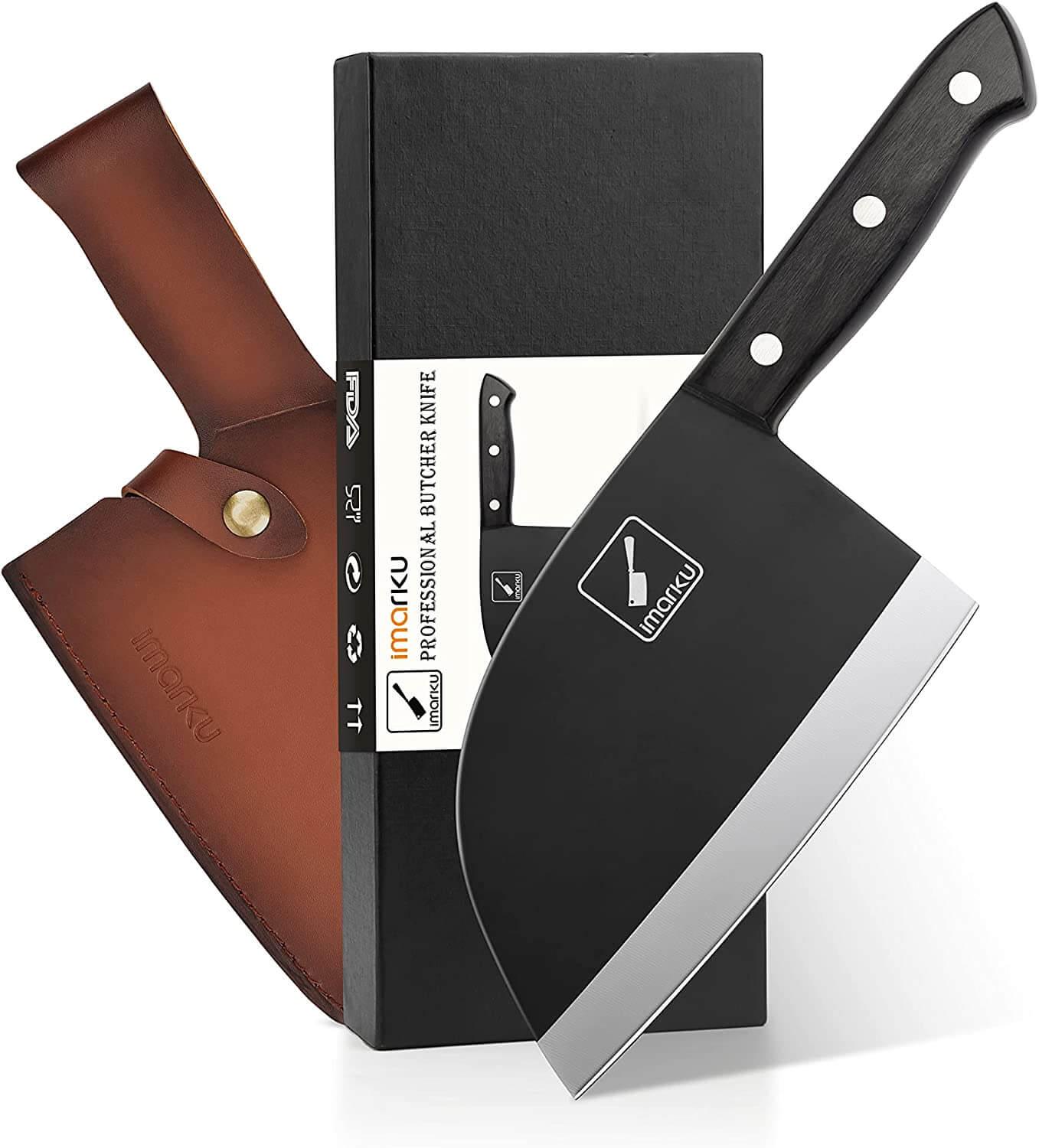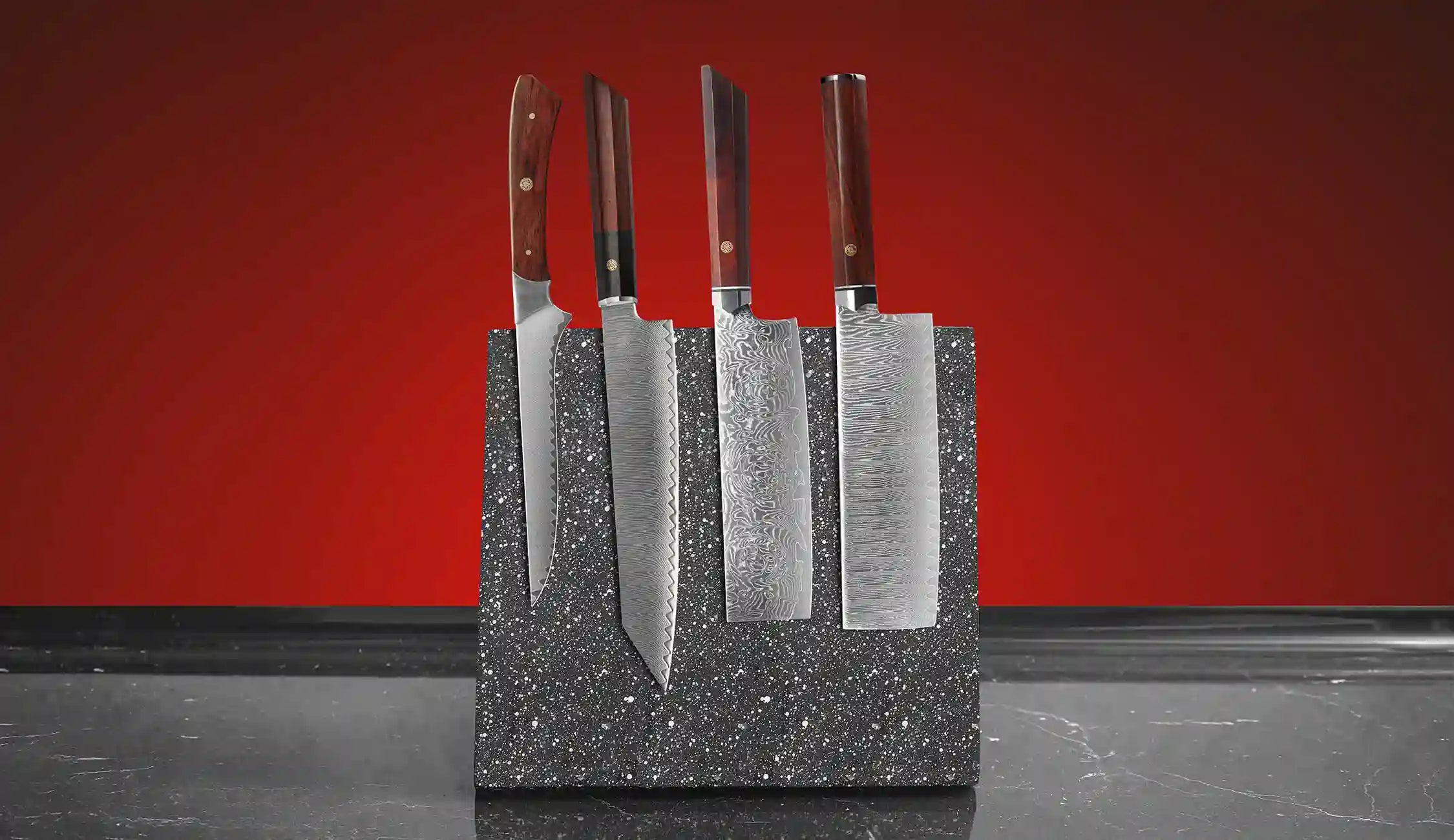TABLE OF CONTENTS
If you've just started to search for quality kitchen knives, you must have come across the term `tang'. It refers to the part of the steel blade that extends to the handle to provide support. Being an important factor in product costs – a knife can be full or partial tang. In this post, we'll discuss full tang vs half tang to help you make a worthwhile investment.
Let's look at how the two compare.
Full tang knives
A full tang knife has a blade that extends from the tip to grip. Generally, the handle is sandwiched between two pieces of plastic or wood using rivets. In most full tang knives, you'll see a solid metal around the blade. However, there're some tangs where you won't see the blade on the handle.
While most manufacturers won't state if a knife is a full tang, it's not hard to figure out. If you use a knife for fire steel striking or batoning without weakening the blade handle joint, then it's a full tang.

A full tang focuses on weight and balance
A full tang increases the overall weight of the knife and ensures balance. Without it, your knife can pull downward at the front. This can lead to fatigue due to the imbalance.
With a full tang, the weight is distributed evenly on the blade to give better balance. And because such knives have a heavier handle, you don't use too much pressure when cutting dense food. If you're looking for a knife for survival situations, a full tang is the best. There's no way to bypass that.
If you see a thin line passing through the top of the handle, there's a chance you have a full tang knife.
How is it made?
This knife is made with a solid piece of metal that starts from the tip to the handle. The handle is made of two slabs of wood that are secured on both sides with rivets. Sometimes, a metal rod is used to give further reinforcement. Since the tang makes up a bigger portion of the handle, the knife can stand up to heavier cutting and chopping.

Uses
This knife is suitable for outdoor activities like levering, chopping, and batoning.
Pros
Offers better leverage – the knife extends the weight evenly. If you use a knife frequently, you should focus on a full tang. The extra weight on the handle offsets the one on the blade, making it an agile tool.
Offers superior strength – when a single metal runs through the full length of a knife, it won't bend. And it can perform under any conditions you throw at it.
The chances of a handle breaking are minimal because more force is applied to the blade.
Cons
Heavier – a full tang means that your knife will weigh more. But with the advancement in technology, there are improvements in metal processing such knives are not as heavy like they once did.
Requires extra maintenance – regular use of the tang can expose the knife to corrosion. This means that it requires extra care in cleaning.

Half tang knives
These are knives whose blades extend through the handle. They are vulnerable to snapping and breaking. But knife manufacturers combat this problem with variations in tag constructions.
Since the length of the handle varies, a tail that is significantly narrower than the blade weakens the knife. The tang can also be grooved and is fastened more securely to the interior of the handle. Most knives fail because the handle separates off the blade where the tang stops. There are a couple of benefits to this type of manufacturing.
How is it made?
There're many ways to attach half tang to a handle. One way is to drill a hole in the grip material and shape it to fill the tang. Then, you can set one or more pins/rivets.
Another method is to split the grip in half (lengthwise) and place the halves on the tang and rivet.
A third way that is becoming more common is using the strength of epoxy to hold the handle – no rivets. However, you can notch the sides of the tang by drilling the holes and locking the grip on.
Keep in mind that tags are a matter of cost factor. You'll find some lightweight blades for decorative purposes.

Uses
A half tang is suitable if you're not concerned about snapping the blade. Of course, this means that you don't mind replacing them often. This knife is suitable for chefs who want to slice tender herbs or a bag of onions without fatigue. Because such knives are not designed to withstand external forces, it's not the best option for cutting something like a watermelon.
Pros
While there are lots of criticisms for half tang, there are also advantages you can bank on.
It's lightweight, so it limits the amount of force you can use on the handle. Because it uses less material, it's easy to carry around or use daily.
Half tangs offer a complete seal against moisture and prevent expansion in the grip.
If you're on a tight budget, a half tang is a sure bet.
Cons
Half tang knives are not as strong as full tang knives. Not to mention, they can't be used for tasks like survival, carving, or anything that can strain the knife. And the chance of breaking or shifting is high.
Some knives compensate for this by adding handles that make it feel like full tang.

Which one is better?
There's no definite answer to this highly subjective question. The tang that suits you best will depend on how you intend to use the knife. Some people argue that you don't need a full tang when chopping veggies and tofu. But again, if you're looking for a knife to do a tough job, a half tang may not be the best. Although a half tang is often cheaper, you have to be ready to spend more in the long term.
Before you purchase a knife, you should know the type of tang to know its strengths and capabilities. If you acquire a knife for any reason and you don't know the type of tang, you should refer to the manufacturer's website.
If you want a camping knife, you should invest in a full tang knife. But if you need a knife to do a few things in the house, a lighter half tang knife sounds perfect.






















Leave a comment
All comments are moderated before being published.
This site is protected by hCaptcha and the hCaptcha Privacy Policy and Terms of Service apply.